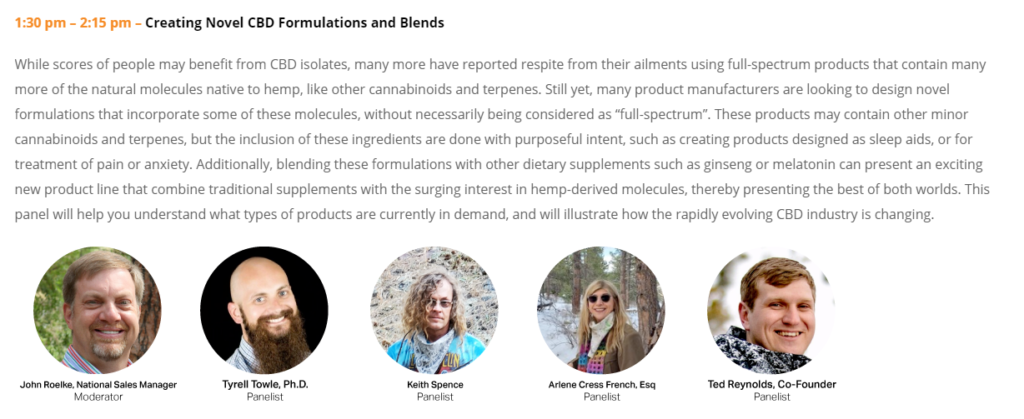
Creating a unique blend of flavor and purpose for your product and brand can be difficult when starting a new business. The following panel discussed the upcoming trends and recommendations they are seeing in the CBD industry currently to aid in the creation or continuation of your CBD business. John Roelke with Extract Consultants was the moderator. While Tyrell Towle Ph.D with MedPharm Research, Keith Spence , Arlene Cress French, Esq. and Ted Reynolds were panelists.

CBD Trends
The first topic of discussion was the newest and latest trends of CBD. When creating novel blends you want to stay up to date with what the market is doing and what the consumer is demanding right now. Many on the panel talked about the current innovation and experimentation with minor cannabinoids. Deciding if your sticking with whether you are going to use isolate or broad spectrum ingredients. Along with the creativity of bioavailable cannabinoids, are having interesting head way in the industry.
For example nasal sprays are becoming more and more popular. As it is becoming more present to try to have the new combo of delivery devices or methods to experience different cannabinoids. This is important to recognize because with an advanced delivery method you need less overall THC in the product. And uses of CBD isolate to create a cause and effect derivative. You can read more about the science of the the upcoming and current cannabinoids research here.
Cause and Effect Tinctures
Cause and effect tinctures are one of the most common trends among CBD currently. For example infusing the isolate of CBN and melatonin staring with a distillate and adding them in for the cause and effect solution and branding as a sleep aid. Still keep in mind that different interactions can impact the CBD efficacy.
Cannabinoids should be seen as the engine while terpenes and tinctures are the steering wheel. Herbal mixtures have been used for thousands of years, and when mixed in with cannabinoids create different mechanisms. Always keep in mind there are known herbal mixtures you shouldn’t do. For example using grapefruit can confuse metabolism in the body and cause an over dosage. However having the correct combination can improve the cannabinoid effect and the time it stays in the body. Be warry of the combinations you are making and always have a product third party tested before selling to the public.
What to look for in a vendor
When creating your product there are certain aspects you should always be aware of.
Specifically your vendors. Make sure to be aware of the quality of their products and what they are extracting. Be accountable and do your due diligence. Ensuring the quality of their system ensures you can proudly market a high quality product yourself. As well as having a solid third party lab that you trust to test your product is essential in the hemp marketplace. While there isn’t a robust amount of options, the brands that do it right from the beginning will maintain a reputation of having quality and legitimate products in the long run. With an increasingly regulated marketplace, being a license holder means many are accountable to peoples livelihoods and in turn connected to licensing. In the long run aiming to keep the industry more accountable.
Branding
Always be cautious of what you are putting on your label. Have the wording and claims established that you feel confident putting out into the marketplace. And always making sure to have your paperwork and references of your established vendors. Regulators such as ASTM, FDA and many others (you can check out the big ones here) can be used as a solid framework for industry standards. We’re still early on in the standardization of this industry. So make sure to cross check what the rules are. And be up to date what other states, such as California, are paying attention to.
Another aspect of branding the panel spoke on was consumers don’t buy ratios and numbers. Consumers buy moods. For example a customer won’t buy a product that states 3:2 ratio in big letters on the box. Stating a 3 to 2 ratio of CBD to THC. However, a customer will buy the box with appropriate coloring or associated icons and pictures that set the stage for what your products effect is trying to achieve. Again make sure to always be cautious of the claims made on your boxes and labels. But alluding to what you are trying to sell, yellow colors for waking up, blue for sleeping, etc. Can sell the mood and not just the numbers game of your product.
Conclusion
In conclusion start at the consumer demand while having a solid foundation that you trust for your supply chain. Entering this market can be difficult as it doesn’t yet have a the same regulations as the food and beverage industry. This can spur innovations i.e. delta-8. Which can put your product ahead in the market but always make sure your product aligns with the ideals of the FDA regulations.

Teagan is the Marketing & Communications Manager for 710Spirits® and Rocky Mountain Reagents. While continually learning about the cannabis industry and all the possibilities it has to offer she creates content for The Canna Consortium both for blog posts and social media. Make sure to check out @thecannaconsortium2.0 for all industry updates and news.
